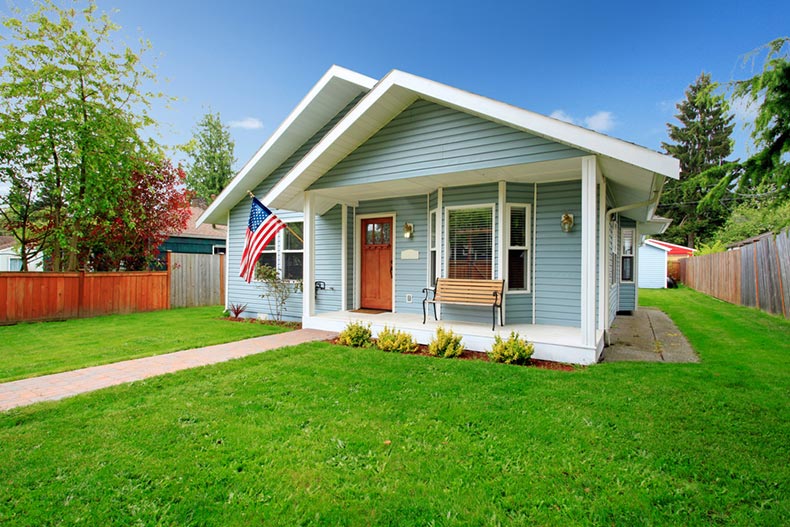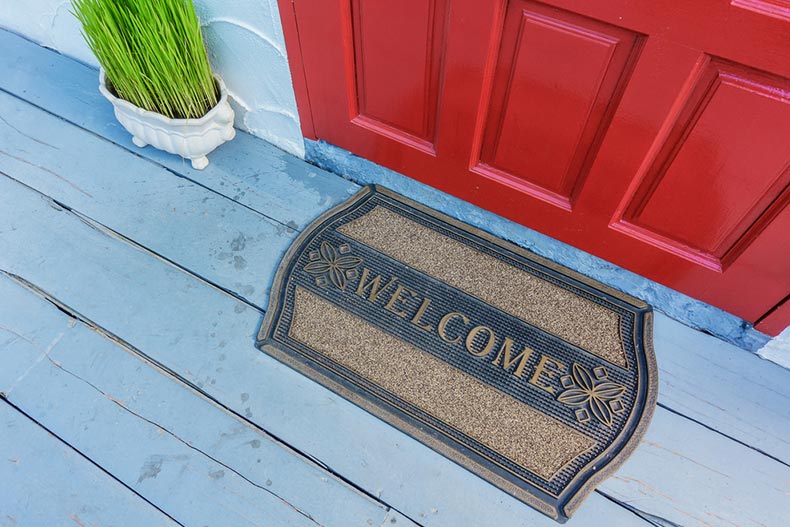It’s often said that moving is one of the most stressful things that people do, but it doesn’t have to be that way. This ultimate guide to moving when you’re over 55 can make your move easier and more organized.
This guide covers many of the important topics you need to consider for your next move, such as deciding when and where to move, finding the right home, downsizing, moving into a 55+ community, moving day tips, and so much more. These moving resources and tips can help you make sure you’re on the right track for your next move. With some careful thinking and planning, 55+ active adults can overcome the stress of a big move and start to look forward to all of the positive changes.
Make your move easier with the ultimate guide to moving when you’re 55+.
Deciding the Right Time to Move

The right time to move certainly depends on many factors and varies greatly from person to person. Many active adults finally decide to move in order to downsize from their family home that has become too large for their needs.
Empty Nest
For homeowners with children who have moved out, the home may have too much space or require too much upkeep. And active adults may feel ready to begin a new adventure in a new place, whether across town or across the country. In this case, downsizing offers an appropriate way to achieve these goals. However, since leaving a family home can also hold sentimental value, the right time to move may be when homeowners feel ready to take the next step in life.
Financial Goals
Other active adults may find that the right time to move occurs when their finances have finally reached a point that supports a long-awaited move to a distant place or even makes it possible to purchase a dream home previously out of reach. Moving can be expensive, after all, and time and money can play a major factor in deciding when is the right time to move. The more time you have, the more financial planning you can secure to make your dreams a reality.
Waiting for the Right Home
Homeowners may also take a more opportunistic approach when it comes to figuring out when to move. Active adults may have already decided that they want to move, but they’re still waiting for the right home to open up in a certain location, such as a sought-after active adult community. A move from a bustling urban area to a more laid-back rural setting is also common, and active adults may be keeping their eye on a certain area for a good home to go on the market.
The Real Estate Market
The state of the real estate market may also contribute to the decision about when to move. Homeowners may be waiting until it’s a favorable buyer’s market before they make the choice to move so that they can get more bang for their buck. The right time to move may even come down to the right time of year since most people tend to move when the weather is pleasant in the spring or fall.
All in all, deciding when to move comes down to the individual household and what preferences and motivations may influence your choice.
Choosing Where to Move

Some active adults might want to stay close to home, which means they want to stay in the same city, state, or area. Active adults moving to New Jersey, New York, or Pennsylvania, for example, might want to stay on the East Coast to live near family. On the other hand, those moving to Illinois and those moving to California would prepare very differently for their moves. If you want to move to a particular state, or if you have an open mind within a certain geographical area, begin by reading guides about moving to these different states to find the location that feels right for you.
Many homeowners explore the possibility of relocating to a retirement destination, such as moving to Florida, Arizona, or Texas. These states offer comfortable climates, abundant recreation, and laid-back lifestyles that appeal to many 55+ active adults who want to plan for retirement. Those moving to North Carolina or moving to South Carolina might be looking for those same exact things.
After deciding whether to stay close to home or move across the country, active adults can conduct their own research to narrow their search even further. If you’re planning years into the future, you have time to take a trip or a vacation to different destinations to seriously explore a new place. The expertise of a local real estate agent can also help you learn about the different neighborhoods and communities that you could call home.
Finding the Right Home

After working through the major decisions of when to move and where to move, active adults can begin earnestly searching for their next home. Some decisions have fewer choices than others, such as whether you prefer a single-family, attached, or condominium home. But when it comes down to square footage, bedrooms, floors, and the rest, 55+ homebuyers certainly have choices to make.
Homebuying Budget
Given the importance of financial security for many active adults, budget plays an important role in the homebuying process. A budget often dictates the size, age, and location of a certain type of home in a particular area. Keep in mind, for example, that a compromise on location might make a newer home more affordable, while a compromise on features might secure a great location. With careful financial planning and research, active adults can often find their dream home for the right price. You might even save money by moving into an active adult community.
Stages of Life
Remember to think toward the future when looking for your next home. If you’re a 55+ active adult who wants to move into your retirement dream home, then make sure to choose a home that can continue to serve you as you move through different stages of your life. Keep an eye out for features like first-floor living and universal design features that can make life easier and ensure that a home continues to meet your needs for years to come.
The Right Community
Finding the right home also means finding the right community. Homebuyers should weigh the benefits of living in an active lifestyle community or an age-restricted community. In addition to personal preference, factors such as budget, location, style, and size should impact the home you want to buy. These search parameters, whether used online or with a local realtor, can help narrow your homebuying search. Just make sure to act fast when you find the right home.
Selling Your Current Home
Many active adults find themselves wearing two hats when they both sell their current home and buy a new home at the same time. To make the home selling process easier, check out the ultimate guide to selling your home on 55places.
Preparing to Move

Before any move, it’s essential to create a plan that can help you prepare for a successful and efficient move. Whether you’re working with family, friends, or experienced realtors, there are several steps homeowners should take to prepare to move.
Make a Timeline
Begin by making a timeline that can help you plan for your move and keep everything else on track. A timeline can help you understand how to make progress and reach your goal. Start by asking yourself when you plan to move into your new home, whether you have a specific date or a general month. Then, you can work backward to understand what needs to get done and when. Keep in mind, though, that a timeline should remain flexible if the time you have to complete your move lengthens or shortens.
Use an App
Active adults might also want to take advantage of useful apps that make moving easier. These apps can help with anything from creating an inventory of items, finding help, and creating a floor plan of your new home. These resources are especially useful for long-distance moves when organization and planning are especially key.
Ask for Assistance
Make sure to also think carefully and realistically about how much help you might need to complete your move. Consider what you can or want to accomplish and what you would prefer to have assistance with. When it comes to packing boxes and moving furniture, many active adults appreciate the help provided by family or professionals. If you decide you need movers, it’s important to find a reliable moving company to help the job get done right.
Financial Considerations
A few other things to contemplate as you plan your move include things like getting moving insurance, contacting your homeowners’ insurance company, and updating voter registration. You can also start looking past your current home and toward the future. Especially when moving out of state, make sure to research important taxes and tax differences between states.
You can also start looking for a doctor, dentist, and vet in your new neighborhood. Where will you grocery shop? What about dry cleaning? And where can you catch a movie, see a concert, or attend a festival? These small, casual decisions about moving can help bring excitement and focus to the moving process.
Downsizing for Active Adults

Most 55+ active adults decide to downsize and move into a smaller or more low-maintenance home that supports their active social and physical lifestyle. One of the best things you can do to prepare for this lifestyle change, and for any major move, is to downsize.
Downsizing refers to a process of, literally, sizing down into a home that fits your life, and you also have to downsize your possessions to match. A move offers a perfect opportunity to downsize possessions because then you have less to pack, move, and unpack. Downsizing can help you have a fresh start in your new home.
Spend some time learning how to downsize, especially after you have lived in your home for decades. Downsize your life by going through all of your possessions, room by room, and deciding what to keep, what to sell, what to donate, what to give to others, and what to discard.
However, downsizing doesn’t mean getting rid of as many things as possible. It’s actually a careful, thoughtful process that has more to do with you and your attitude than it does with your things. Make sure to watch out for some common things to avoid when downsizing your home.
Moving Day Tips

Moving day—or days if the distance between locations is far—can be stressful for even the most experienced homeowner. With so many moving parts—no pun intended—the process of getting your belongings out the door and into another can feel overwhelming. Luckily, we have several tips to keep you organized and focused on the day of the big move.
Stay Organized
Staying organized is key to planning and performing a move, and a great way to do this is by keeping a pre-written to-do list for the day of the move. Any and all tasks that need to be completed that day should be on the list, including any cleaning that needs to be done, last-minute packing, and anything else of importance. With so much going on, the small but important tasks can sometimes be overlooked.
Keep Track of Your Belongings
Homeowners should also keep careful track of their inventory on the day of the move. Any packed boxes or items in forgettable places should be moved into the open for the movers, and any items or furniture that need to be protected during the trip to the next home should be appropriately secured and wrapped. There are several apps that allow you to keep an itemized list of all of your belongings. Another tip is to pack an essentials bag beforehand that has overnight clothes, toiletries, and everything needed before the boxes in the next home are unpacked.
Be Ready to Work
Having the right attitude and mindset also ensures that moving day goes smoothly. Being comfortable is important, so wear clothes that are easy to move in and will allow you to be at a good temperature throughout the day. Make sure to eat a good breakfast and lunch to stay energized and focused. Also, stay hydrated and make sure everyone helping with the move is also drinking enough water. Keeping your phone, keys, and essentials bag in a designated place will also prevent any last-minute scrambling to find these things.
Take One Last Look
Finally, complete a thorough and methodical walk-through of your home once everything is moved out. Check every room, storage space, and even the refrigerator to make sure that nothing is left behind that shouldn’t be. Perform any necessary chores, like taking out the trash, and see to it that no lights are left on. Make sure the thermostat is at an appropriate temperature for your home to be vacant, and lock all doors and windows on your way out. By staying organized and calm on moving day, homeowners can make moving day a lot easier on themselves.
Moving Into a 55+ Community

For many active adults, moving into a 55+ community means taking on a new lifestyle full of new friends, experiences, and activities. Active adult communities come in all shapes and sizes and can be anywhere from tight-knit and quiet to large enough to have their own zip codes and towns within them.
When searching for communities to consider, active adults should find neighborhoods in preferable areas of their choice that include amenities and lifestyle activities that align best with their individual preferences or include new hobbies they may want to try. While 55+ communities often have many retired members, homeowners don’t have to be retired as long as they meet the minimum age requirement set by the community.
Low-Maintenance Living
Many 55+ communities feature low-maintenance or maintenance-free homes that are managed by homeowners’ associations (HOAs) that take care of all landscaping, exterior home maintenance, and common area maintenance. Life without having to do yard work can certainly be appealing to many active adults because it leaves more time for trying new things or relaxing.
Plenty of Amenities
The included amenities that often come with a 55+ community are often what attract active adults to consider moving into one. Depending on the community, the amenities can sometimes be mind-blowing in scale and convenience, such as massive clubhouses with multiple activity spaces, indoor and outdoor pools, golf courses, athletic courts, and on-site restaurants. Prioritize two or three amenities that you would love to have in your new community to narrow down all of the available options.
Socially Active
Speaking of trying new things, many communities include extensive social calendars filled with clubs, events, and social gatherings. Depending on the community there could potentially be something to do every day of the week and many opportunities to try out new hobbies or meet new people. Communities host a wide variety of specific hobby clubs based on the interests of included homeowners, so finding like-minded individuals can be as simple as checking out the schedule and showing up to the next meeting of a club.
Settling Into Your New Home

You did it—you moved! Now, it’s time to settle into your new residence and make it feel like home. You can decorate, unpack, and enjoy the process of personalizing your new home and getting to know your new community.
Homesickness
Of course, it’s completely normal right after a move to experience some homesickness. Active adults who move across the country—such as from Arizona to Illinois or from Arizona to California—often experience some disjointed feelings because the lifestyle varies from their previous home. Don’t worry: You can cure homesickness sooner than you think.
Meet Your Neighbors
As soon as possible, get to know your new neighbors. Next-door neighbors can be some of the best guides to a new community or a new town. Many active adult communities have designated welcoming committees to invite new residents into the community. Make sure to check out the social calendar to find some events or gatherings to visit.
And most of all, enjoy the satisfaction and excitement that comes with any well-planned move.








